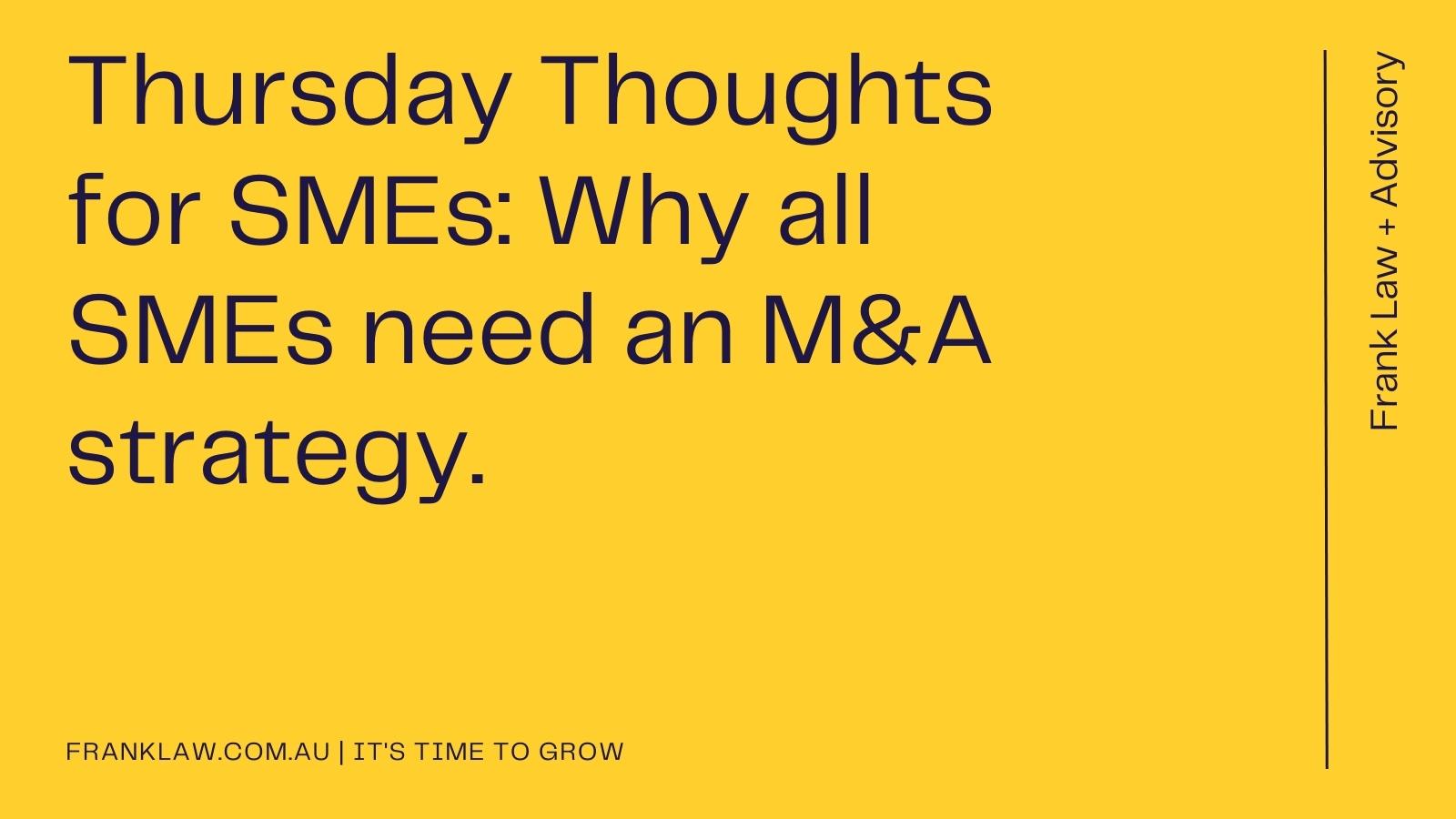M&A. Mergers and Acquisitions. Buying and Selling.
If you run an SME and you do not have an M&A strategy you are missing out.
What is an M&A Strategy?
An M&A strategy is a clearly articulated and documented strategy outlining why you would contemplate an acquisition or merger, how it would benefit the company and what it may look like. It will be intimately linked through to your broader strategy plan but will drill down into the key specifics of a target or scenario and the parameters of a deal.
Why should an SME have an M&A strategy?
There are 3 key reasons why an SME should have an M&A plan: Growth, Arbitrage and Resilient Scale.
Growth.
If a business is not growing it is dying. There are 2 key ways a business can grow; organically or through acquisition.
Organic growth is usually the least risky but takes the most amount of time. Growth through acquisition or merger can be riskier but also can dramatically accelerate the growth of the business in a shorter period of time.
Whilst not all businesses are ready to acquire, having a clearly articulated M&A strategy can help provide a ‘north star’ and set some key milestones as to when an acquisition should be considered.
We have had clients double their turnover in less than 6 months off the back of acquisitions. A clearly defined M&A strategy can accelerate business growth. Combine this with an organic growth strategy and big things can happen!
Arbitrage.
Most people have no idea about arbitrage. In my view it is the most incredible tool that most SME owners don't know about.
Arbitrage is the simultaneous purchase and sale of the same or similar asset in different markets in order to profit from tiny differences in the asset's listed price.
In practice SME arbitrage occurs when SME1 (valued at 3 x earnings) buys SME2 for say 3 x earnings and post acquisition, the group earnings are at sufficient scale to attract a higher multiple should the group now sell. Post acquisition, SME1 now has sufficient scale to be valued at 4 or 5 x earnings (4x or 5x) if it sold in the same market.
Let’s put some numbers to the scenario. SME1 makes $2M in EBITDA and is valued at $6M (3x). SME2 makes $1.25M EBITDA and is valued at $3.75M (3x). SME1 buys SME2. Post acquisition, SME1 now makes $3.25M in earnings and is valued at $13M(4x) or $16.25M(5x) by virtue of SME1 now having scale in their earnings. By SME1 spending the $3.75M they have potentially added between $3.25M and $6.5M to the enterprise value of the business.
SME owners need to look around and see the exodus of other SME owners (baby boomers) who run good solid businesses and who will sell them for reasonable multiples.
By having an M&A strategy the SME owner can quickly and efficiently identify deals which would make sense and deals which would not. They can be clear as to parameters and lock in a deal which they know will add to the value of the business and not detract from it.
We have a client who clearly identified what targets would look like and were able to put together a clear plan to target them ‘off market’ thereby increasing the ability to lock in a value adding deal.
Resilient Scale.
Many SMEs are one bad debt or event away from failure. The fragility of a smaller operation is often rationalised by the owner in terms of earnings.
“If I grow too much more the earnings will reduce and I will earn less because of more overheads”.
Yes that is often the case (for a period) but there is a significant other benefit which is the underlying resilience of the business increasing. A bigger business is less likely to be catastrophically impacted by a bad debtor or event. A bigger business, if well run, should have effective capital reserves and facilities to smooth out any operating changes. Whilst this may result in lower direct earnings to the owner in the short term, the long term benefits significantly outweigh any short term pain.
A resilient business by definition needs to have scale. Low customer concentration, management, systems, processes and facilities in place.
By having and implementing an M&A strategy you can increase a business’ resilience by increasing its scale.
We have seen this amongst our clients. As they have added business units to their operation, they have significantly reduced the external risk of failure and created a sustainable operating business.
Summary
All SMEs need to have an M&A strategy.
Having an M&A Strategy will better prepare the business for when opportunities present themselves and enable a faster, more accurate decision making process.
If you have any questions or need any assistance developing an M&A strategy please reach out. We at Frank Law + Advisory regularly assist clients in relation to M&A strategy, transactions and advice.






